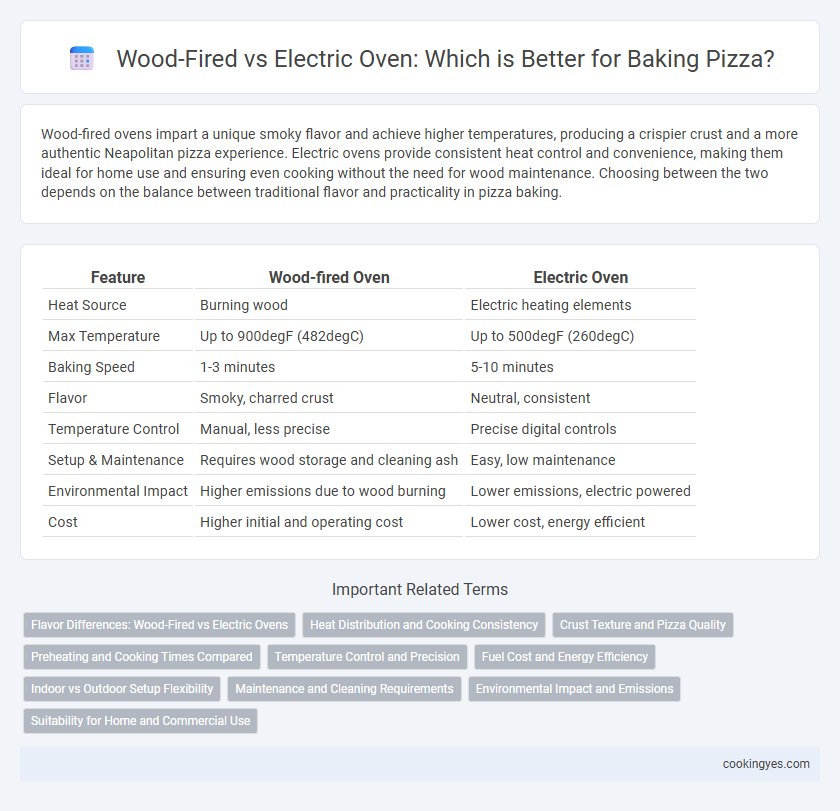Wood-fired ovens impart a unique smoky flavor and achieve higher temperatures, producing a crispier crust and a more authentic Neapolitan pizza experience. Electric ovens provide consistent heat control and convenience, making them ideal for home use and ensuring even cooking without the need for wood maintenance. Choosing between the two depends on the balance between traditional flavor and practicality in pizza baking.
Table of Comparison
| Feature | Wood-fired Oven | Electric Oven |
|---|---|---|
| Heat Source | Burning wood | Electric heating elements |
| Max Temperature | Up to 900degF (482degC) | Up to 500degF (260degC) |
| Baking Speed | 1-3 minutes | 5-10 minutes |
| Flavor | Smoky, charred crust | Neutral, consistent |
| Temperature Control | Manual, less precise | Precise digital controls |
| Setup & Maintenance | Requires wood storage and cleaning ash | Easy, low maintenance |
| Environmental Impact | Higher emissions due to wood burning | Lower emissions, electric powered |
| Cost | Higher initial and operating cost | Lower cost, energy efficient |
Flavor Differences: Wood-Fired vs Electric Ovens
Wood-fired ovens impart a smoky, charred flavor to pizza due to combustion of hardwood, enhancing the crust's texture with slight crispiness and a complex aroma profile. Electric ovens offer more temperature control but lack the natural smokiness, resulting in a cleaner, less robust flavor and a softer crust. The choice between wood-fired and electric ovens significantly influences the taste experience, with wood-fired pizzas often preferred for their rustic, authentic flavor.
Heat Distribution and Cooking Consistency
Wood-fired ovens offer superior heat distribution thanks to radiant heat from the flames and heat-retaining brick surfaces, resulting in evenly cooked, crispy crusts with characteristic smoky flavors. Electric ovens provide more consistent temperature control and steady heat, ensuring uniform cooking but sometimes lacking the intense, fast heat that creates the perfect pizza texture. For optimal heat management and cooking consistency, wood-fired ovens excel in artisanal quality, while electric ovens deliver reliability and precise temperature settings for home and commercial use.
Crust Texture and Pizza Quality
Wood-fired ovens reach temperatures above 800degF, producing a charred, crispy crust with a smoky flavor that enhances pizza quality. Electric ovens typically heat up to 500-600degF, resulting in a more evenly cooked crust but lacking the distinctive texture and taste of wood-fired baking. The intense heat of wood-fired ovens quickly cooks the pizza, creating an airy, blistered crust favored by authentic Neapolitan pizza enthusiasts.
Preheating and Cooking Times Compared
Wood-fired ovens reach high temperatures of 700 to 900degF, enabling pizzas to cook in just 90 seconds to 3 minutes, significantly reducing overall baking time. Electric ovens typically preheat to around 500degF and require 7 to 12 minutes to cook a pizza, with longer preheating periods of 20 to 45 minutes. Faster preheating and cooking in wood-fired ovens result in a crispier crust and distinct smoky flavor, while electric ovens provide more consistent temperature control for even baking.
Temperature Control and Precision
Wood-fired ovens reach temperatures above 900degF, providing intense heat that creates a crispy crust and smoky flavor, but temperature control can be challenging and requires experience. Electric ovens offer precise temperature settings, typically ranging from 200degF to 500degF, allowing consistent baking conditions ideal for uniform cooking and reproducible results. For professional or home bakers prioritizing accuracy and ease, electric ovens provide better temperature regulation, while wood-fired ovens excel in delivering distinctive taste profiles through high heat.
Fuel Cost and Energy Efficiency
Wood-fired ovens typically incur higher upfront fuel costs due to the continuous need for quality hardwood, but they offer superior energy efficiency by retaining and radiating intense heat evenly for authentic, crispy crusts. Electric ovens, while featuring lower fuel expenses and more consistent temperature control, generally convert energy less efficiently, leading to prolonged baking times and potentially higher electricity consumption. Comparing both, wood-fired ovens demand more manual fuel management yet excel in energy retention, whereas electric ovens provide convenience with lower recurring fuel costs but may sacrifice overall thermal efficiency.
Indoor vs Outdoor Setup Flexibility
Wood-fired ovens offer outdoor setup flexibility, creating authentic, high-heat environments ideal for traditional pizza textures and flavors, but their installation is typically limited to open-air spaces due to smoke and ventilation needs. Electric ovens provide greater indoor convenience with compact designs and easy installation, allowing year-round pizza baking regardless of weather conditions. Choosing between these ovens depends on space availability and desired cooking ambiance, balancing the rustic charm of wood-fired setups against the practicality of electric models.
Maintenance and Cleaning Requirements
Wood-fired pizza ovens demand regular cleaning of ash and soot to maintain optimal heat and prevent buildup, with occasional chimney inspections to ensure proper ventilation. Electric ovens require less intensive maintenance, featuring removable trays and easy-to-clean surfaces suitable for quick wipe-downs after use. Both types benefit from routine checks, but wood-fired ovens generally involve more hands-on upkeep to preserve performance and safety.
Environmental Impact and Emissions
Wood-fired pizza ovens emit higher levels of carbon monoxide and particulate matter due to incomplete combustion, contributing to local air pollution and deforestation concerns if wood is sourced unsustainably. Electric ovens produce significantly lower direct emissions, especially when powered by renewable energy, resulting in a smaller carbon footprint and reduced environmental impact. Choosing electric ovens aligns with efforts to reduce greenhouse gas emissions and improve urban air quality.
Suitability for Home and Commercial Use
Wood-fired ovens offer intense, radiant heat reaching up to 900degF, ideal for authentic Neapolitan-style pizzas with crispy crusts, making them preferred in commercial pizzerias for high-volume, traditional baking. Electric ovens provide consistent temperature control and ease of use, making them more suitable for home kitchens and small businesses prioritizing convenience and energy efficiency. While wood-fired ovens create unmatched flavor profiles, electric ovens excel in uniform cooking, lower maintenance, and suitability for limited spaces.
Wood-fired vs Electric oven for pizza baking Infographic

 cookingyes.com
cookingyes.com